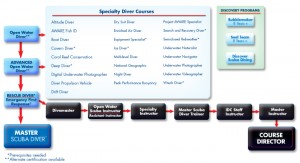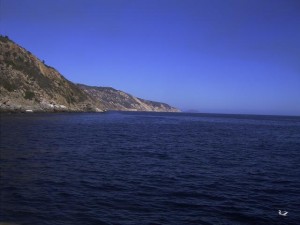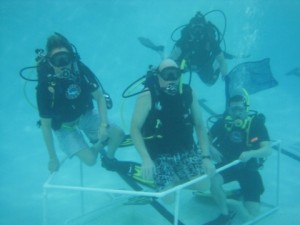Born to Dive, Forced to work? What if work could be diving? You can go from non-diver to PADI Professional (dive master or instructor) within six months. You can go from working in a dreary cubicle to leading divers and students over coral reefs around the world. If you’re already a certified diver, it can take a lot less time than six months.
Before we dive in to the diving lifestyle, there is one caveat. Being a PADI Pro doesn’t mean that you’re just going to be lounging on the beach. There is work to be done, but even a bad day diving is a helluva lot better than sitting in a cubicle staring at a computer screen.
Here are the steps to become a PADI Pro:
* Complete the PADI Open Water Diver course (in as few as four days, but some more time is probably better)
* Complete the PADI Advanced Open Water Diver course (a bit of self study and five dives over two days and you’re there)
* Complete the PADI Rescue Diver Course (Probably plan on five to seven days here. Most divers that take it say it’s the toughest, funnest diving course they’ve ever taken.)
* Log at least 29 other dives than the ones you’ve done in Open Water, Advanced and Rescue. [You need forty to start Divemaster.] These could be in Specialties. More on that in a bit.
* Complete the PADI Divemaster Course (this will take a month or so, once you work in all of the practical sessions and internship requirements, but it is essential experience to have before becoming an instructor.)
* You’ll need to have at least sixty logged dives to wrap up Divemaster and enroll in a PADI Instructor Development Course. You also need to be a certified diver for at least six months.
* Take the PADI Instructor Development Course, IDC, and then take/pass your PADI Instructor Examination, IE.
Those are the steps but what do they really mean?
In Open Water, you learn the basics for diving safely with a buddy. In Advanced, you advance your skills and learn more about navigation and make a deep dive and three other dives in specialty areas like fish identification, diver propulsion vehicles, search & recovery, altitude, boat diving, underwater videography, etc. In Rescue, you learn how to prevent and respond to problems (read more about that in my last blog post). Divemaster develops your leadership and supervision skills (watch for my next post on Divemaster). The PADI IDC teaches you how to teach and gives you opportunity to practice your skills before demonstrating to an examiner from PADI that you’re up to the challenge. You can take your IE almost anywhere in the world. The same standards apply world-wide.
Now, you need to have a minimum number of dives to start and end Divemaster and a minimum number to become an Instructor. These dives can be logged during training and they can just be fun dives (highly recommended). One option for racking up more dives are PADI Specialty Diver courses. These can be a great investment in your future, since they’ll expose you to a variety of specialized diving activities. They build on the material you learn in Advanced and take it further, with guidance and supervision from an Instructor.
Now you’re a PADI Open Water Scuba Instructor, OWSI. Remember all of the courses you just took? You can now teach most of them. A new PADI OWSI can teach Open Water Diver, Advanced, Rescue, Divemaster and a few specialties (Peak Performance Buoyancy, Project AWARE and AWARE – Coral Reef Conservation). You can also conduct diver experiences like Discover Scuba, Bubblemaker and SealTeam. You can teach most of the Adventure dives in the Adventures in Diving (Advanced/Adventure Diver) program, but not all of them. For example, you need training and experience and certification to conduct certain diving activities like Enriched Air(EANx)/Nitrox and side mount Diving.
What can a typical day look like for a PADI Pro?
Get up, shower, shave, put on your swim suit and head to the dock. Make sure the dive boat is ready to go, scuba kit is on board for your divers and that the scuba cylinders are full. Check the weather and make sure you’ve picked out a good site for the divers in your care. Meet with your divers and get them aboard the dive boat. Now, motor out to the reef and give your divers a thorough briefing about the dive they’re about to make. Once everyone is kitted up, get them in the water and lead them on a descent to the reef. Watch the group carefully to make sure everyone is safe and having a good time. Point out the cool things to see on the reef, especially the subtle things that divers might otherwise miss. Once you’ve hit your planned dive time, deploy your DSMB (delayed surface marker buoy) so the boat knows where you are. Then lead the group to the surface after a safety stop at fifteen feet. Make sure everyone boards the boat safely, do a last minute check and then motor on to the second dive site of the day.
At the end of the day, make sure equipment is cleaned and tanks are filled, then go relax with your divers at the restaurant or bar. Diving is a social activity.
OR….
Arrive at the dive shop fifteen minutes before opening. Check that everything is clean and ready for customers. Fill a few tanks, check the rental stock and make sure the classrooms are clean. Flip on the display lights and the OPEN sign. Then phone starts to ring. Divers looking for an upcoming trip. Get them signed up and have them bring in their gear for a quick check or annual maintenance before they go on the trip. You hang up and someone walks into the shop looking for new fins. You spend some time showing various fin features. Then you invite the customer to try them out in the pool. Luckily, they brought their swimsuit. Get them in the pool while you fill a few more tanks. The customer hops out of the pool and wants to buy the fins, so you get them taken care of. The phone rings again, a customer with questions about classes. You take down some information and get them signed up for Open Water Diver. Later in the day, your coworker that watches the shop in the afternoon comes in. You tell them about the morning and you go get ready to teach your afternoon/evening class. Around five, your students start walking into the shop. You greet them and direct them towards a classroom where you’ll go over their homework and tell them about what they’ll be doing in the pool tonight.
OR…
Maybe you’ve got a good day job and just want to make scuba more than just a hobby, maybe a part-time job. You meet your students at the dive shop in the evening for their final class and pool session before the open water dives. After reviewing their homework, you all head out to the pool. You planned something different for tonight. Beyond some of the normal skills, you’ve a few games set up in the pool to practice buoyancy control and just have fun. One of your dive masters is waiting for you with their camera to capture the fun for your student divers.
OR…
Maybe you’re a backpack traveler and want to spend a few months in the Caribbean, then a few months in the Mediterranean, then some time in Fiji before coming home for a couple months of skiing before doing it again.
OR…
Get the idea? There is an endless way you can escape from your 9-5 job and do what you love for a living. So what are you waiting for? Dive in and live the adventure!



